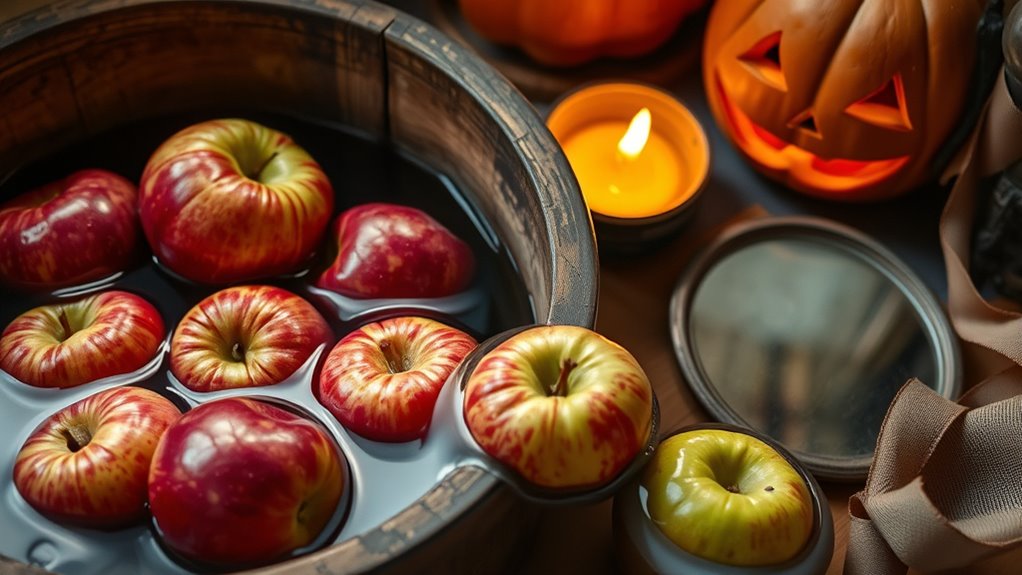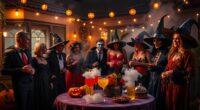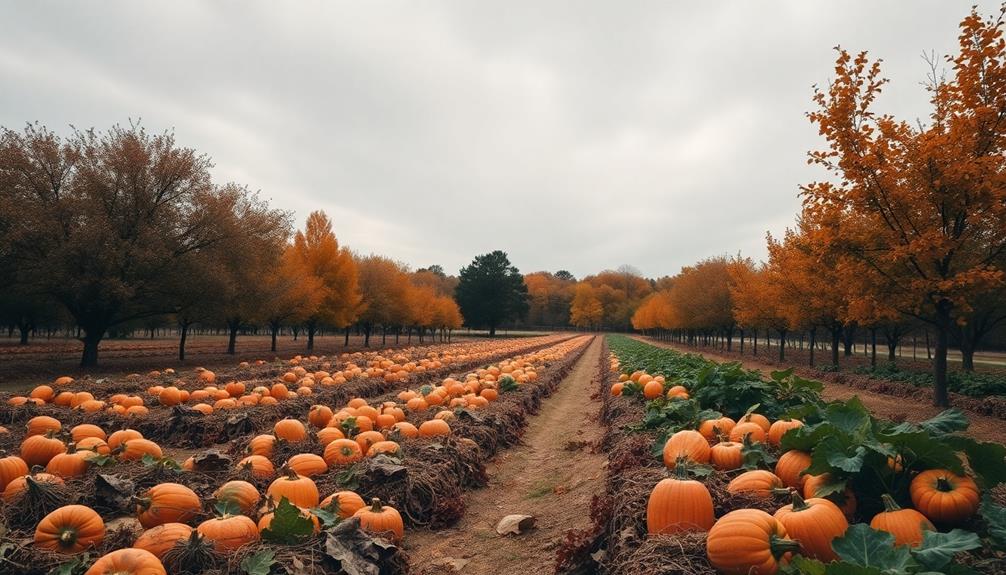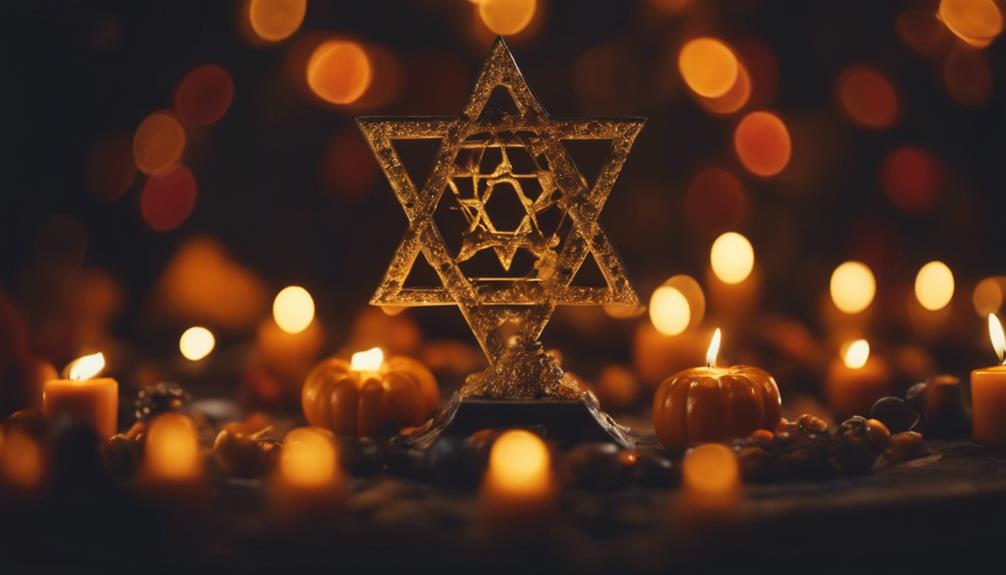Many Halloween traditions you know today, like bobbing for apples and trick-or-treating, come from centuries-old customs that have faded or changed over time. For example, bobbing for apples was once part of a marriage fortune-telling game, and door-to-door visits for treats evolved from community prayers and gatherings. These practices reflect deep-rooted folklore and community bonding. Keep exploring to discover more fascinating, forgotten Halloween customs that shaped the holiday’s history.
Key Takeaways
- Traditional activities like bobbing for apples date back to ancient Celtic harvest festivals.
- Mumming and wassailing involved dressing in costumes and visiting homes for blessings or treats.
- Lighting bonfires was a common Halloween ritual to ward off evil spirits.
- Divination games, such as reading tea leaves or mirror gazing, were used to predict future love or fortune.
- Early Halloween customs often included storytelling of local legends and ghost stories to honor spirits.
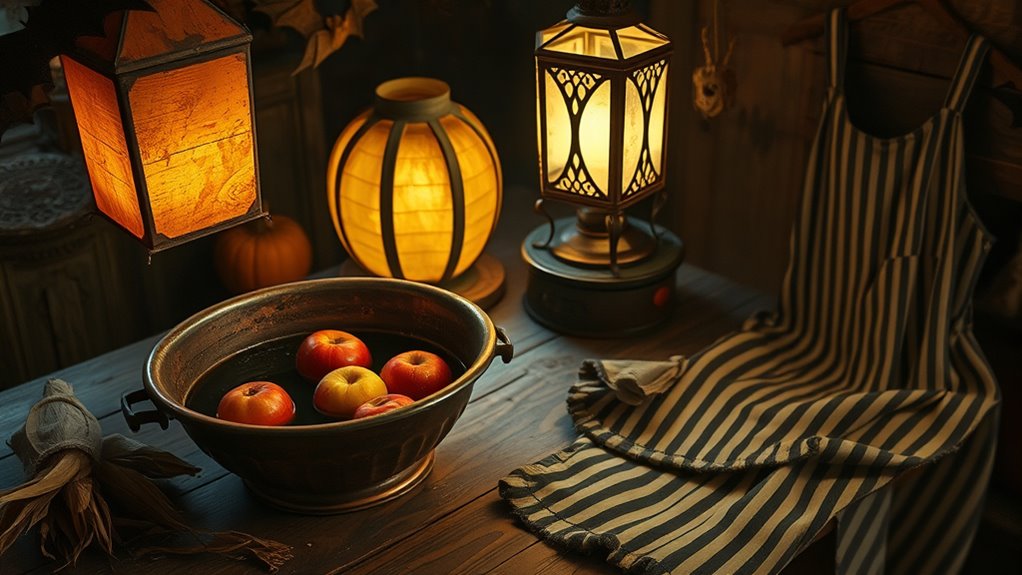
Have you ever wondered how Halloween traditions have evolved over the years? It’s fascinating to think about how many customs we now associate with the holiday have roots stretching back centuries, some fading into obscurity. For example, haunted house stories have long been a staple of Halloween, but their origins are deeper than you might realize. Originally, these tales served as warnings or moral lessons, often passed down orally from generation to generation. Today, haunted house attractions are elaborate and commercialized, but their core idea—spooky stories meant to thrill and scare—remains the same. As you walk through a haunted maze, you’re participating in a tradition that’s persisted for centuries, even if the stories have become more theatrical and less about ancient superstitions. Incorporating interior decor elements into haunted house designs can enhance the eerie atmosphere and make the experience even more immersive.
Another tradition you might not think about as much is pumpkin carving. While it’s one of the most recognizable symbols of Halloween, the techniques we use today have evolved considerably from simple, rough carvings. In the past, people carved faces into turnips or potatoes, which were more difficult to work with and didn’t produce the same vibrant glow we associate with jack-o’-lanterns now. Over time, pumpkin carving techniques modernized—precise tools, stencils, and intricate designs—transforming the pumpkin into a canvas for art and creativity. This shift reflects how Halloween has become more about individual expression and spectacle. But beyond the carving itself, the tradition is rooted in older customs of warding off evil spirits, where the flickering candle inside the pumpkin was believed to scare away lurking spirits. Today, you might spend hours perfecting a spooky face or a detailed scene, but the underlying purpose of safeguarding your home remains part of the tradition, even if it’s now more symbolic than practical.
As you think about these traditions, it’s interesting to realize how they intertwine with stories and skills that have been passed down through generations. Haunted house stories, for instance, often draw on local folklore and historical legends, giving each community its unique flavor. Meanwhile, pumpkin carving techniques have become a craft that combines artistry with superstition. Even though many of these customs have faded from everyday practice—like bobbing for apples or trick-or-treating in its original form—they still influence how we celebrate today. These forgotten traditions remind us that Halloween isn’t just about costumes and candy; it’s a tapestry of history and storytelling, woven into the very activities that thrill and unite us. So, next time you carve a pumpkin or listen to a haunted house story, remember that you’re participating in a legacy that’s been shaping Halloween for centuries.
Frequently Asked Questions
When Did Bobbing for Apples Originate?
You might wonder when bobbing for apples first started. The history origins trace back to Roman times, where it was linked to fertility rituals during harvest festivals. Its cultural significance grew in 19th-century America, symbolizing love and matchmaking. Today, this playful tradition still captures Halloween fun, connecting us to ancient customs. You can enjoy it knowing you’re part of a centuries-old celebration that blends history, culture, and festive joy.
Are There Other Traditional Halloween Games Besides Bobbing?
Besides bobbing for apples, you can enjoy pumpkin carving and sharing ghost stories around the fire. These traditional Halloween games create fun and spooky atmospheres, making the holiday memorable. You might also organize a costume contest or play themed scavenger hunts. These activities, like pumpkin carving and storytelling, help you celebrate Halloween’s history and enjoy quality time with friends and family, making the night special beyond just the usual tricks and treats.
How Did Halloween Costumes Evolve Over Centuries?
You’re curious about how Halloween costumes evolved over centuries. You’d find that early costumes reflected the history of ghost stories and superstitions, often disguising wearers to avoid spirits. Over time, the evolution of pumpkin carving and pop culture influences shaped costumes into creative, expressive outfits. Today, costumes blend history and modern trends, making Halloween a vibrant celebration of imagination and tradition, transforming how you and others enjoy the holiday each year.
What Are Some Regional Halloween Customs Worldwide?
You might think Halloween customs are universal, but regional folklore and cultural variations tell a different story. In Mexico, you celebrate Día de los Muertos with colorful altars, while in Ireland, they honor the spirits with bonfires and storytelling. From Japan’s spooky ghost festivals to Italy’s masked parades, each region adds its unique twist. So, get ready to embrace these diverse traditions and perhaps start your own global Halloween adventure!
Why Are Black Cats Associated With Halloween?
You might wonder why black cats are linked to Halloween. Superstitions surround black cats, often portraying them as witches’ familiars or omens of bad luck. However, myth versus reality shows that black cats are simply pets with no magical powers. Historically, they symbolized good luck in some cultures, but over time, fear and superstition made them Halloween icons. You might see them as mysterious, yet they’re just animals with a misunderstood reputation.
Conclusion
As you uncover these forgotten Halloween traditions, you realize how much fun they brought to the holiday. Imagine a small town reviving apple bobbing, where kids cheerfully compete for the prize, creating new memories. Reintroducing these customs can add a nostalgic, unique touch to your celebration, connecting you with centuries of Halloween history. So next Halloween, why not try something different—like bobbing for apples—and make your night truly unforgettable?
